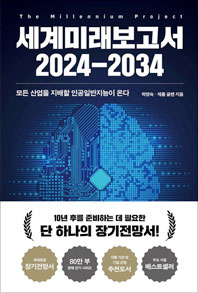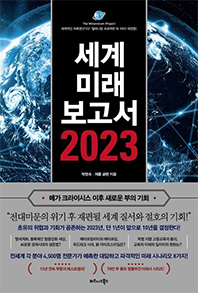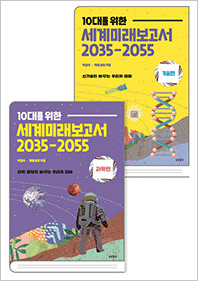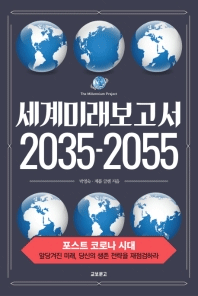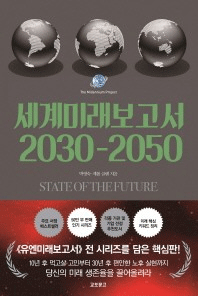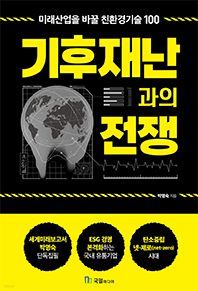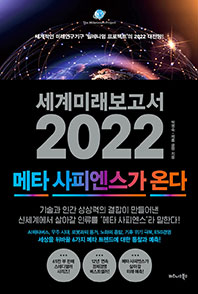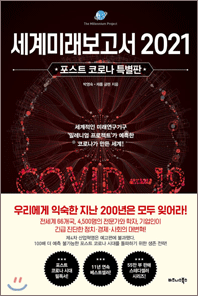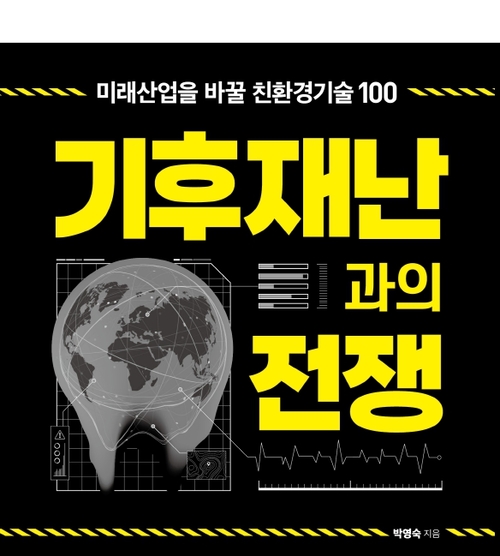50년전 밀레니엄프로젝트 창립회장인 테드 고든이 공동발명한 미래 게임을 읽어보자. 제롬 글렌
For the future historically minded, see the link below about the Future game Ted Gordon co-invented over 50 years ago!
50년전 밀레니엄프로젝트 창립회장인 테드 고든이 공동발명한 미래 게임을 읽어보자. 제롬 글렌 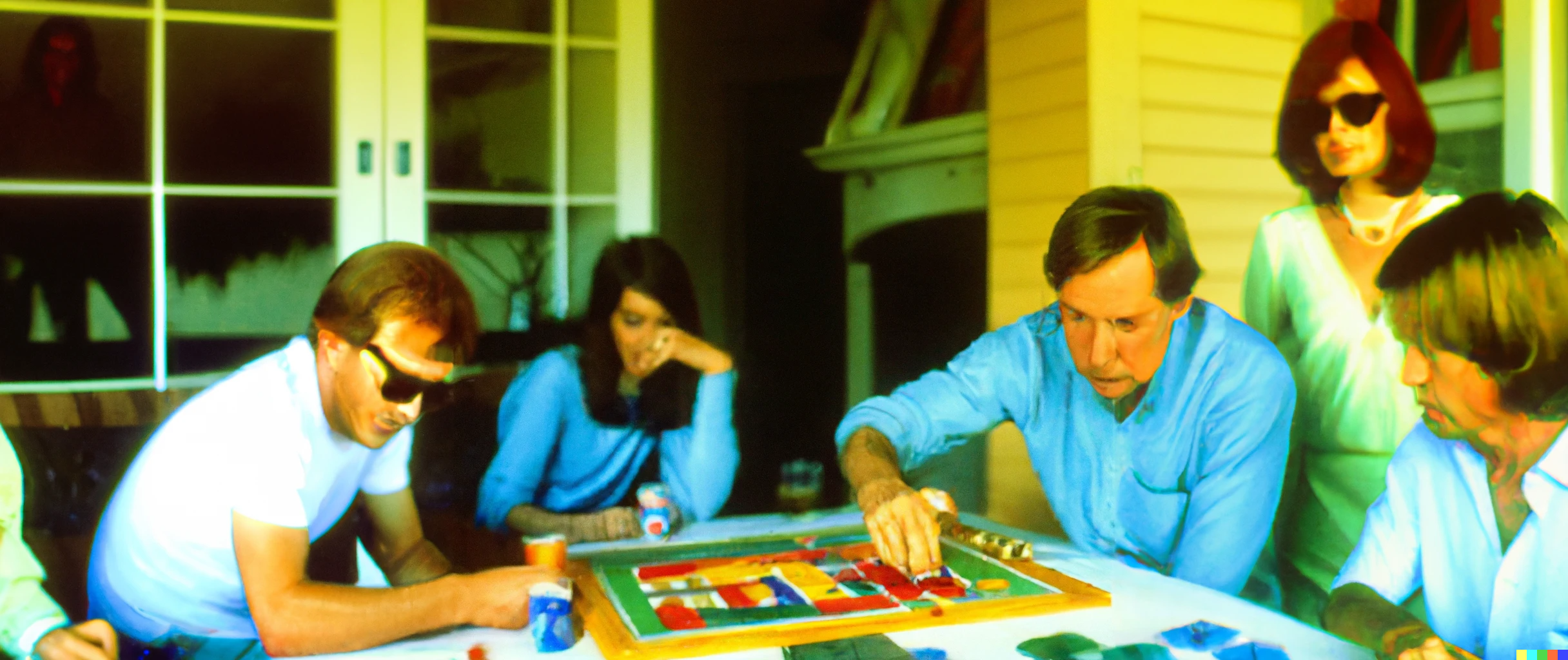 이미지: Dall-E2 이미지: Dall-E2나1967년 12월 크리스마스 직전입니다. 할리우드 스타이자 청량음료 업계의 거물인 Joan Crawford가 맨해튼 아파트의 식탁을 가로질러 손을 뻗어 마지막 10억 달러 지폐를 게임판에 밀어 넣습니다. "여러분," 그녀는 테이블 주위에 배열된 동료 PepsiCo 이사들에게 " 1986년까지 로켓선을 통한 상업적 운송 수단을 갖게 될 것입니다 ." 대륙 반대편 말리부에서 또 다른 조안 디디온은 집에 모인 손님들에게 신문 헤드라인을 냉소적으로 읽어줍니다. "다음 선거는 새로운 국민 컴퓨터에 의해 결정될 것입니다." 탁자 건너편에서 미래의 캘리포니아 주지사인 제리 브라운(Jerry Brown)이 그에 따라 게임 말을 움직이며 한숨을 쉬고 있습니다. 미국 수도의 동쪽에 있는 워싱턴 DC Pied-à-terre의 파티오에서 Bob McNamara 국방부 장관은 20면체 주사위를 손가락으로 두드리고 워싱턴 포스트 소유주인 Katherine Graham과 동료 포토맥 사교계를 응시 하고 있습니다 . "확률 80퍼센트, 케이티… 숫자는 절대 거짓말을 하지 않아."  미국 전역의 다른 곳에서는 디너 파티와 게임의 밤이 Monopoly 나 The Game of Life 가 아니라 조금 더 정교한 것, 즉 정원 클럽에서 중미 레크리에이션에 이르기까지 위대하고 선한 사람의 예지력을 테스트하는 예측 게임으로 이어집니다. 방. 1970년대 초반까지 지폐, 주사위, 현기증 나는 미래의 가능성으로 채워진 밝은 색상의 탁상용 게임 덕분에 전국의 모든 계층의 사람들이 읽기와 함께 일상적인 기술 세트에 예측을 추가할 수 있었습니다. , 쓰기 및 산술. 미국은 응접실 예지자의 나라가 되었습니다. 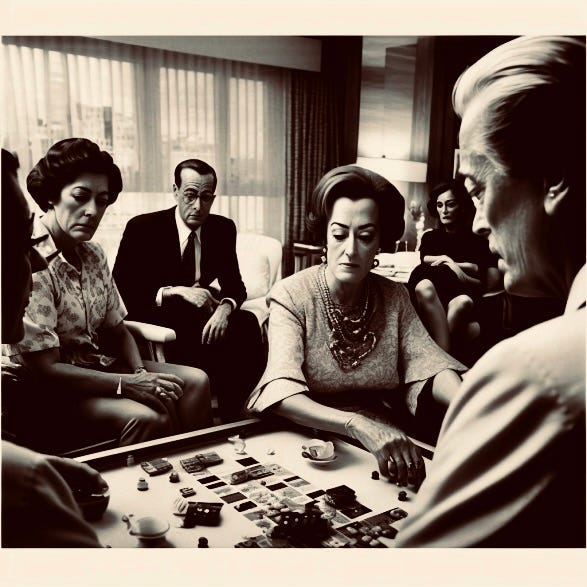 에스유감스럽게도 이 비네트는 허구이며, 캐주얼한 예측가의 미국은 결코 만들어지지 않았습니다. 그러나 문제의 게임은 실재했지만 소수의 수집가와 선견지명이 있는 역사가를 제외하고는 오랫동안 잊혀졌습니다. 그것이 무엇이고 그것이 무엇을 의미하는지 이해하면 문화로서 우리가 미래에 대해 호기심을 가질 수 있지만 여전히 끔찍한 예측가로 남아있는 이유에 대한 통찰력을 제공합니다. Future: A Game of Strategy, Influence and Chance는 거의 알려지지 않았음에도 불구하고 20세기 중반 테크노크라시의 중요한 인공물이었습니다. 그것은 확률을 가르치려고 시도한 다음 위대하고 선한 사람의 벽장과 다락방으로 나타난 것처럼 거의 빨리 사라지는 다채로운 보드 게임이었습니다. 그러나 과학적 계획과 탁상용 인포테인먼트를 연결하는 수단으로서의 존재 자체가 놀랍고 그 역사는 말할 가치가 있습니다. 저는 이 시점에서 기득권을 주장할 것입니다. 저는 전문 미래학자 이고 거의 20년 동안 해당 분야에서 일해 왔습니다. 미래 작업의 역사와 인공물은 특히 우리가 사회로서 미래를 어떻게 이해했는지 이해하는 방법과 미래에 대한 아이디어를 다른 사람들과 상상하고 조사하고 공유하는 방법을 구축하는 방법으로 저에게 깊은 관심을 가지고 있습니다. 내 관심은 예측의 정확성이 아니라 예측 과정이 미치는 영향과 그것이 사회를 형성하는 방식에 있습니다. 그런 점에서 Future는 독특한 경계 대상이었습니다. 과학적인 틀을 깨고 싱크 탱크와 메인 스트리트 사이의 경계를 넘으려는 시도였습니다. 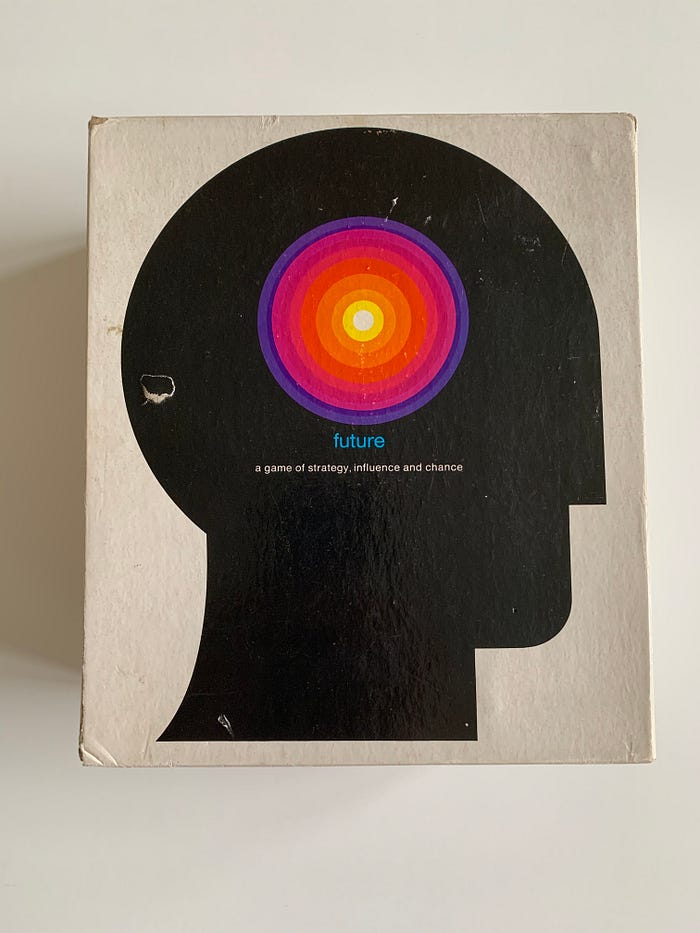 나는 오랫동안 게임을 알고 있었고 직접 보고 싶었지만 어느 날 저녁 eBay의 유휴 스크롤이 희귀한 사본을 제공할 때까지 살아남은 원본 중 하나를 얻을 것이라고 예상하지 못했습니다. 몇 번만 클릭하면 불확실하지만 유통되는 소수의 살아남은 사본 중 하나가 영국의 게임 수집가에서 헤이그의 앞발로 향했습니다. 얼마 지나지 않아 꼼꼼하게 테이핑된 소포가 도착했습니다. 내부에는 멋진 산세리프체로 " 미래"라고 쓰여진 세련된 일러스트레이션이 있는 상아색 종이 상자가 있습니다. 나중에 나는 컬러 버스트 뇌가 있는 윤곽이 있는 머리가 있는 표지 삽화가 게임 커미셔너인 캘리포니아주 오클랜드의 Kaiser Aluminium & Chemical Corporation이 그 시기에 실행한 광고 캠페인에서 그린 것임을 나중에 알게 되었습니다. 게임 상자 측면에는 1966년 저작권이 손으로 찍혀 있었습니다. 뚜렷한 표지 삽화는 1960년대 후반에 산업 고객과 대중에게 미래를 전도하는 것을 목표로 한 Kaiser 캠페인의 반복된 모티프였습니다. 상자 안에는 지난 수십 년 동안 게이머들에게 20면체 다이로 알려진 플라스틱 20면체와 함께 조립된 게임 보드를 구성하기 위해 함께 장착된 색상 슬라이더가 있는 작고 거의 현대적인 성형 플라스틱 콘솔 세트가 쌓여 있었습니다. 다음으로, 10억 달러와 50억 달러 단위의 4가지 색상의 랙에 장착된 게임 칩과 수축 포장된 통화 팩 2개 — 예, " b"가 있는 10 억 달러 입니다 . 게임판 아래에는 조심스럽게 구멍을 뚫은 양면 "트렌드" 시트와 마찬가지로 구멍을 뚫은 일련의 투기성 신문 헤드라인이 게임판 중앙의 못에 맞도록 디자인된 섬세한 더미가 있었습니다. 둘 다 게임 플레이를 지시하는 종이 계산기 역할을 하도록 설계되었습니다. 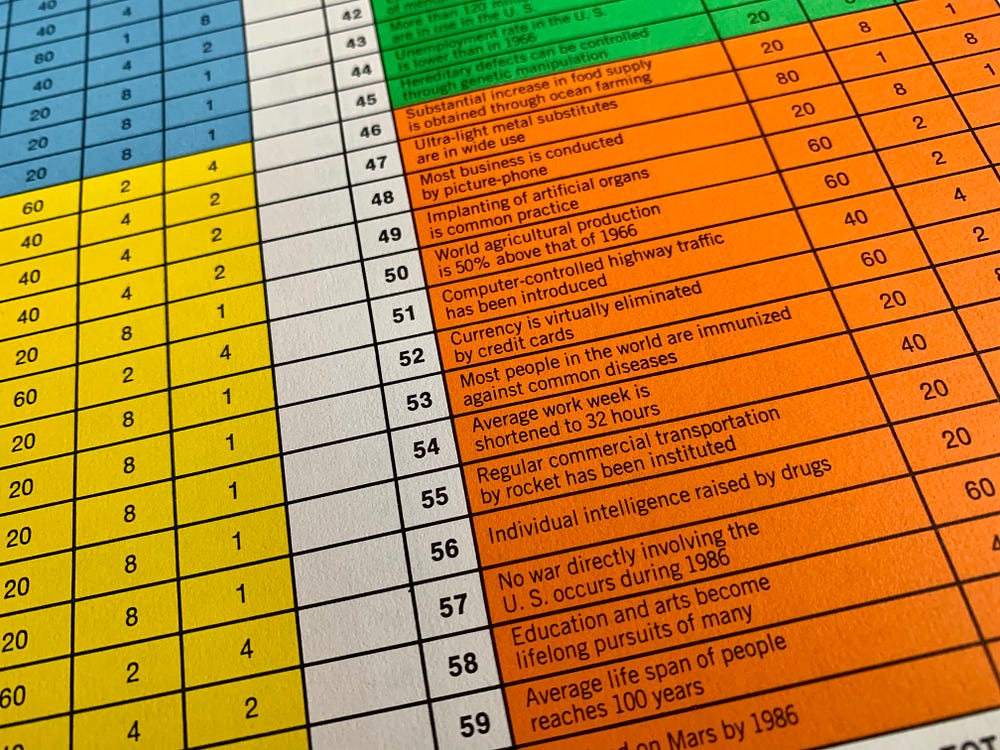 플레이 보드를 읽으면 내기를 걸 수 있는 미래의 가능성 목록을 접하게 되는데, 그 중 다수는 1966년에서 2023년 사이에 시간에 갇힌 것처럼 보입니다: 보장된 연간 수입. 성격 조절을 위한 약물. 사진 전화로 비즈니스. 인공 장기의 일반적인 사용. 상업 우주 탐사. 주 4일 근무. 뇌-컴퓨터 인터페이스. 무료 대학. 인종 장벽 제거. 분명히 Future 는 Candyland 나 Stratego 가 아니라 새롭고 다른 것입니다. 1966년부터 본 미래에 대해 가르치도록 설계된 정교하지만 매력적인 보드 게임입니다. 학교나 다른 맥락에서 그것을 접한 사람들은 가능성에 대한 감사와 가능한 미래를 형성하는 것으로 우리가 생각하는 힘 사이의 상호 연결에 대한 이해를 갖게 됩니다. 게임의 주요 요소는 변화이며, 가장 중요한 것은 단 하나의 획기적인 혁신과 성과, 새로운 정부 정책 또는 시장 변화를 통해 변화 에 영향을 미치는 것입니다 . 게임 내에서 이러한 요소를 혼합하면 변경 가능성이 변경되며, 이러한 조합을 가지고 노는 것은 미래가 자주 상호 연결된 변수의 둥지라는 생각에 플레이어를 노출시키기 위한 것이며 하나의 돌파구 또는 변화의 가능성은 종종 다음과 같습니다. 다른 것과의 연결. G사회와 전략의 복잡성에 대해 생각하는 방식은 1966년에 완전히 새로운 것이 아니었습니다. Polymath Buckminster Fuller는 이전에 리소스 관리의 복잡성을 시뮬레이션하려는 시도인 World Game을 제안하고 설계했습니다. 오늘날의 보드 게임과 비디오 게임과 유사한 형태와 형식을 사용하는 것으로 알려진 워 게임은 제2차 세계 대전 중에 전 세계 기획실에서 진행되었습니다. 그러나 Future는 미래 예측의 역학 및 사회적 상호 작용에 민간인을 참여시키려는 최초의 주목할만한 시도였습니다. 그 핵심에서 Future는 John L. Taylor가 Architectural Digest 에서 게임에 대해 쓴 것입니다.1969년에 "교육 기술"이라고 불렸지만 상아탑 추구로 보일 수 있는 것에 어느 정도 접근성을 제공하기 위한 것이었습니다. 게임 제작의 촉매제는 Kaiser Aluminium & Chemical Corporation의 20주년 기념일이었지만 Future 의 주요 개발자는 아니었습니다.. 2차 세계 대전 이후 회사의 급속한 확장을 기념하기 위한 특별한 선물을 마련하기 위한 노력의 일환으로 항공기 및 선박용 금속을 미국 정부에 공급했으며 나중에는 자동차, 냄비 및 프라이팬, TV 디너 트레이에 이르기까지 모든 것을 공급했습니다. Kaiser 향후 20년 동안 장기 계획을 지원하는 전설적인 RAND Corporation에 접근했습니다. Kaiser의 요청은 RAND가 더 많은 청중에게 그 능력을 가르칠 수 있는 무언가를 만들어 달라는 것이었습니다. 당시 자동차, 주택 및 알루미늄과 같은 제품을 포함하는 모든 제품의 성장 시장이었던 곳에서 자체 벤처를 통해 성공을 거둔 Kaiser는 산업계의 리더들이 변화에 대한 큰 베팅이 어떻게 세상을 자신의 이익에 맞게 유용하게 구부릴 수 있는지 이해하기를 원했습니다. 그러나 카이저가 미래에 대한 대중의 상상력을 자극한 것은 이번이 처음이 아니다. 이 회사는 공공 건축을 위한 측지선 돔 부터 초현대적 차량 설계, 원격 이동성 및 사이버네틱스 논의에 이르기까지 모든 분야에 도전했으며 수십 년 동안 대중의 마음에 미래를 메시지로 전달하는 데 깊이 투자했습니다. 캘리포니아의 디즈니랜드 공원에 있는 Disney's Tomorrowland 의 초기 임차인이었으며 알루미늄의 현재와 미래에 대한 약속을 방문자에게 판매했습니다. 1960년대 Kaiser의 출판 담당 이사인 Don Fabun은 Kaiser의 회사 잡지에 실린 초기 기업 미래주의에 대한 삼중의 시도를 "변화 의 차원" 을 포함하여 여러 권으로 편집했습니다.” 및 “ 변화의 역동성 ”, 둘 다 사회, 기술, 식품, 모빌리티 등에서 다가올 변화를 살펴보았습니다. 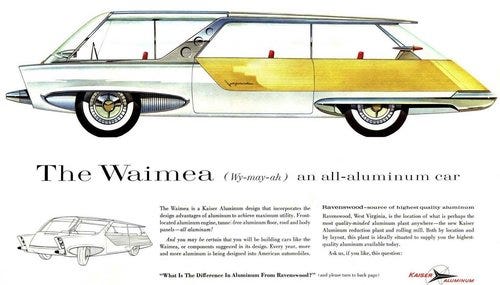 미래 의 기본 아이디어더 이른 개시가 있었다. 1964년 산타모니카에 기반을 둔 RAND("연구 및 개발"의 약자)는 이미 장기 전략 분야에서 세계 최고의 권위자였습니다. 제2차 세계대전 후 Douglas Aircraft Company에서 분리된 RAND는 미국 정부가 전쟁 노력에 함께 일했던 가장 똑똑한 사람들을 유지하고 새로운 사람들을 끌어들이려는 시도였습니다. 이 그룹은 주로 과학 및 군사 문제에 관심을 갖고 위성의 타당성에서 핵 충돌 가능성에 이르기까지 모든 것을 연구했습니다. 그러나 1960년대 초까지 RAND는 사회 경제적 미래의 신흥 영역을 고려하도록 확장되었으며, 이는 미국이 국내에서 해외만큼 또는 스푸트니크가 보여준 것처럼 우주 공간에서도 많은 위험에 직면하고 있다는 광범위한 인식을 반영했습니다. 1964년, 냉전이 격화되고 미국 사회 상황이 뜨거워지자 RAND는 두 명석한 사람에게 향후 50년 동안의 중요한 장기 추세에 대한 최초의 종합 조사를 의뢰했습니다. 그룹 예측의 새로운 방법을 실험하는 작업을 위해 RAND는 파이프 담배를 피우는 독일 태생 교수의 완벽한 대중 문화 구현인 논리학자이자 우미학자인 Dr Olaf Helmer와 젊은 엔지니어인 Theodore "Ted" Gordon을 활용했습니다 . 초기 우주선 개발을 관리하던 Douglas Aircraft에서 임대 컨설턴트로 일했습니다. 그 결과는 향후 50년 동안 진지한 미래학자를 위한 기본 도구가 된 델파이 방법의 개발 을 연마했을 뿐만 아니라 미국이 미래에 잠재적으로 직면할 수 있는 일련의 장기적인 추세를 생성했습니다. 해당 기간 동안의 확률에 대한 전문가 평가로. 그런 다음 그들의 예측은 해당 분야의 최고 전문가에 의해 검증되고 필터링되었습니다. Helmer와 Gordon이 작성한 보고서( 장기 예측 연구 보고서 )는 향후 수십 년 동안 군사, 상업 및 학계 전문가들이 적용할 예측에 대한 체계적인 접근 방식의 토대를 마련했습니다. 그것은 또한 Helmer가 나중에 "소셜 기술"이라고 불렀던 미래에 대한 세련된 관점에 도달하기 위해 "전문가 네트워크"의 집단 지식에 의존하는 개념을 더욱 강화했습니다. 이러한 접근 방식의 측면은 오늘날 시나리오 계획에서 Philip Tetlock과 Dan Gardner의 베스트 셀러인 Superforecasting 에 설명된 점점 인기를 얻고 있는 예측 토너먼트에 이르기까지 모든 것에 나타납니다 . Helmer와 Gordon은 또한 Future 에서 이러한 개념의 확장을 보았습니다.수용 가능하고 유용한 관행으로서 장기 중앙 계획의 아이디어를 되살리는 방법으로서의 게임. Helmer가 1967년 초 The Futurist 잡지 에 썼듯이 이러한 종류의 하향식 계획은 냉전과 사회주의와의 연관성으로 인해 대중의 관점에서 "악취"로 오염되었습니다. 주방 테이블 게임 케이aiser는 미래에 관심이 있는 Kaiser 엔지니어인 Hans Goldschmidt 박사를 통해 1966년 여름 RAND에 연락했습니다. Goldschmidt는 자신의 상점 지그와 모델을 만드는 것을 좋아하는 주말 땜장이였으며 그 중 일부는 특허를 받았습니다. Gordon은 2020년 대화에서 나와의 관계, 특히 Kaiser가 연락을 취한 이유를 다음과 같이 회상했습니다. -범위 예측 연구는 1964년에 발표되었습니다. 우리는 친구였으며 Kaiser로부터, Hans Goldschimdt로부터 전화를 받았습니다. 그것을 기념하고 우리는 그것을 고객에게 보내고 싶습니다.'” Goldschmidt는 적절한 순간에 콜을 했습니다. Gordon은 UCLA에서 시내 전역에서 가르치고 있었고 대학의 새 컴퓨터에 대한 그와 Helmer의 아이디어 중 일부를 연구하고 있었습니다. 이 실험의 일부는 예측 데이터로 시뮬레이션 게임을 구축하고 RAND 서클에서 점차 보편화되고 있는 관행인 변형을 통해 플레이하는 것과 관련되었습니다. 그 결과 또 다른 새로운 방법론인 교차 영향 매트릭스가 탄생했습니다 . 한 추세의 확률이 다른 추세에 미치는 영향을 계산할 수 있게 됨으로써 Gordon과 Helmer는 서로 다른 추세의 영향을 서로 연결하여 시뮬레이션을 실행할 수 있었습니다. 훨씬 더 복잡한 최신 게임 엔진의 간단한 버전입니다. 예를 들어 추세 A가 자체 확률로 추세 B와 거의 같은 시기에 발생한 경우 추세 B가 발생할 확률은 결과적으로 변경될 수 있습니다. Gordon에 따르면 이 접근 방식의 씨앗은 그를 RAND의 궤도에 진입시킨 작업에서 나왔습니다. “더글라스에서 저는 제가 정말 좋아하는 일을 하고 있었습니다. “그 당시 나는 'The Future'라는 책을 썼고, 그 책을 쓰기 위해 RAND로 가게 되었습니다. 왜냐하면 제가 이 책을 쓰는 데 사용한 기본 방법은 해당 분야의 최첨단에 있는 사람들을 인터뷰하고 그들에게 간단한 질문을 하는 것이었기 때문입니다. '어디로 갈 것 같니?'라고 물으세요.” Goldschmidt가 RAND에 접근했을 때 Helmer와 Gordon은 유용할 수 있는 무언가가 주머니에 있다는 것을 깨달았습니다. 바로 미리 만들어진 예측 게임이었습니다. 이에 더해 Kaiser는 RAND 팀에게 전권을 위임 하여 이를 특별한 것으로 만들었습니다. Gordon은 "그것은 경품이었고 Kaiser Company의 자원은 본질적으로 우리가 마음대로 사용할 수 있었습니다."라고 기억했습니다. “우리에게는 전문 아티스트가 있었습니다. 우리가 플라스틱으로 만들고 싶다면 그들은 우리를 위해 플라스틱으로 만들 것입니다. 그래서 우리는 디자인과 관련하여 제한이 없었습니다. 우리는 우리가 원하는 것은 무엇이든 할 수 있습니다. 그래서 우리는 실제로 어느 날 앉아서 이것이 플레이하는 것이 재미있을 것이라고 말했습니다. 그리고 우리는 카드를 구성하는 사건이나 발전의 목록을 만들었습니다. 그리고 그 목록에 대한 우리 자신의 판단이 실현되었습니다.” 게임 개발 프로세스는 반복적이었고 특정 가이드북을 따르지 않았습니다. 고든에 따르면 산타모니카 3번가에 있는 RAND의 사무실에서 일부 역학 및 개념을 작업했는데 그곳의 방은 수학자들과 새로 구입한 컴퓨팅 도구로 넘쳐났지만 그 핵심은 주말에 Helmer의 West LA에 앉아 조용한 시간을 보냈습니다. 다양한 접근 방식을 가정에서 테스트합니다. "저는 올라프의 집에서 주방 테이블에 앉아 게임 레이아웃을 정했습니다." 고든이 말했습니다. “냅킨 뒷면이 아니라 식탁 표면이었다.” 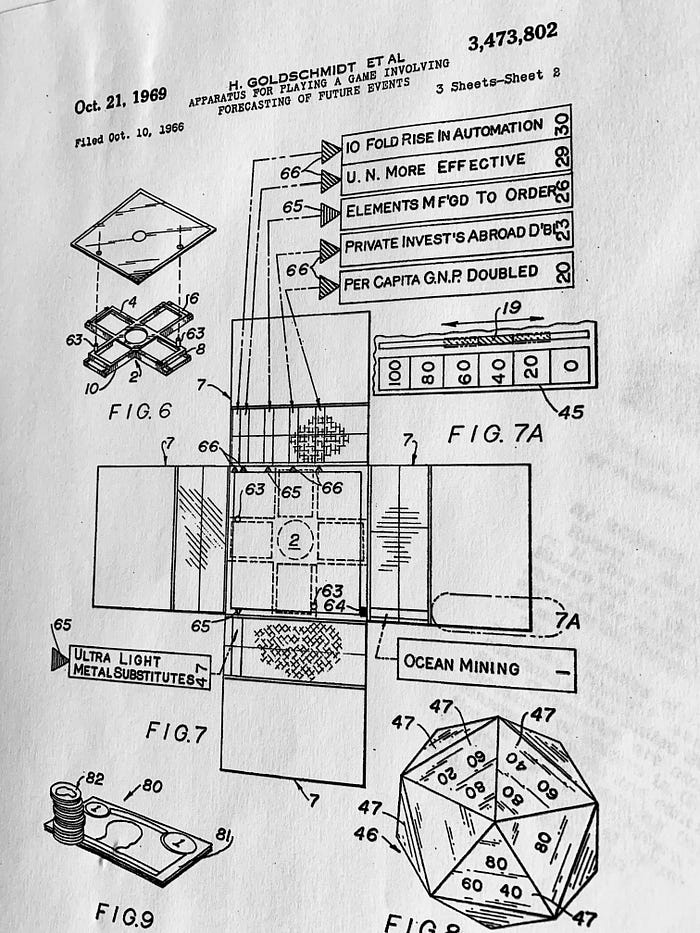 Helmer와 Gordon의 종이 버전에서 Kaiser는 프로덕션에 적용하기 위해 약간의 변경을 했습니다. 고든은 그 과정이 1966년 여름에 3~4개월이 걸렸고 대략적인 일정만 따랐다고 회상했습니다. 그들이 도달한 것은 그 시대의 대중 시장 제품의 세련된 모양과 느낌을 가진 탁상용 게임이었습니다. Milton Bradley와 같은 즐거움 상자, 다채로운 라벨, 일치하는 플라스틱 동전, 통화 및 슬라이더, 조립할 부품, 영리한 플레이 시스템, 주제가 무모한 주제에도 불구하고. Monopoly 와 Life 게임에 익숙한 플레이어는 Formica 식당 세트에서 또는 지하실 카펫 타일에 흩어져 집에서 Future를 열 것입니다.토요일 밤에. 마찬가지로 잘 생긴 상자와 눈길을 끄는 톤은 대부분의 Future 상자가 착륙할 예정인 경영진의 세련된 사무실 분위기에 어울리지 않았습니다 . 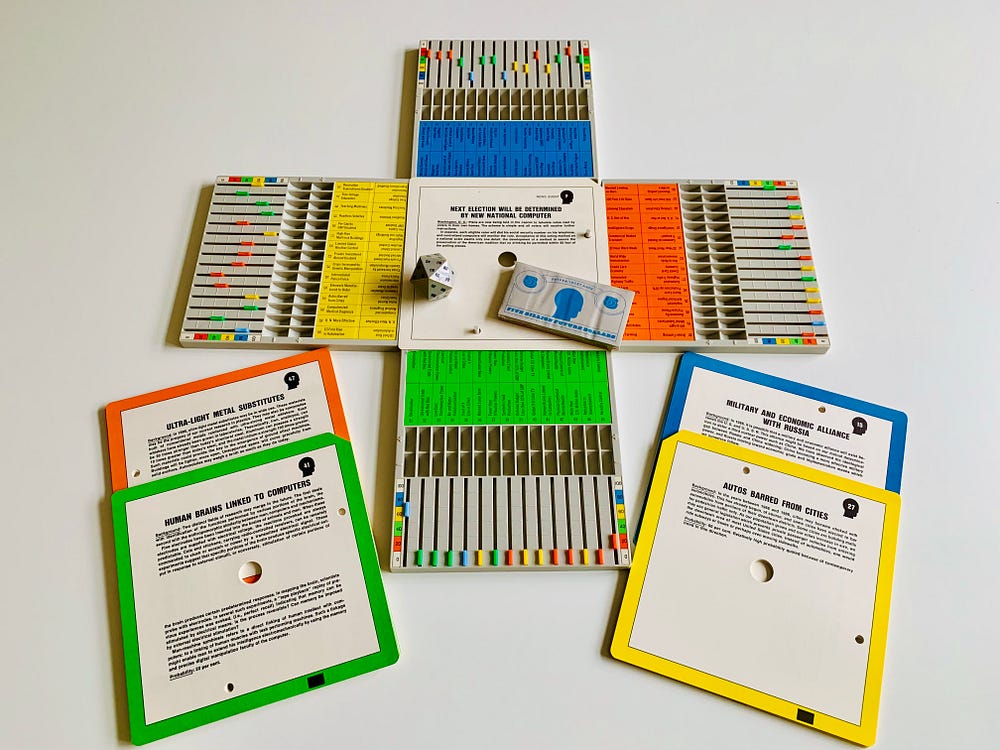 미래를 연주하다 시간ow 복잡성을 재생 가능하게 만드나요? 다행스럽게도 스타터 예측이 있으면 "무엇" 문제가 해결되었습니다. 장기 예측 연구 보고서 에서 다루는 주제는 Helmer와 Gordon이 선택한 다른 문제로 보강되어 미래에 발생하거나 발생하지 않을 수 있는 60개의 "사건" 또는 문제를 제공했습니다. 각 플레이어에게는 80%(예: "4명 중 3명이 도시와 마을에 거주할 것" 또는 "유인 군사 우주 기지가 존재합니다")에서 20%("연간 임금 모든 가장에게 $6,000를 보장합니다”, “정신 질환의 효과적인 물리적 치료가 가능합니다”), 20% 단위로 감소합니다. 각 이벤트에 대해 게임 보드의 해당 색상 슬라이더는 전문가가 결정한 확률로 설정됩니다. 다음 재료는 "언제"였습니다. 슈퍼 예측 또는 예측 시장과 마찬가지로 예측을 게임으로 만들려면 주장을 검증하기 위한 지불 날짜가 필요합니다. 예측의 유효성을 구체적으로 측정할 수 있는 날짜 가 필요합니다 . 그렇지 않으면 예측으로 남게 됩니다. "Future"의 경우 Helmer와 Gordon은 소스 연구의 대상 날짜를 20년 후인 1986년으로 잡고 Kaiser의 20주년 기념과 대칭을 설정했습니다. 1946년 이후로 정치, 과학, 사회에서 그렇게 많은 일이 일어났다면 앞으로 20년이 더 지나면 어떻게 될까요? Future는 또한 "방법" 또는 1986에 도달하는 방법이 필요했습니다. 여기에서 20면체 주사위가 등장했습니다. 각 이벤트가 전문가 확률로 설정되면 앞서 언급한 보상 또는 미래 발생을 생성하기 위해 무언가가 필요했습니다. 각 이벤트를 읽을 때 주사위를 굴리면 위쪽 면에 3개의 숫자 세트가 제공되며, 전문가가 설정한 확률과 일치하는 경우 1986년까지 예측이 "참"인지 여부를 플레이어에게 알려줍니다. 여기까지 Future는 라스베거스의 Hi-Lo 를 변형한 게임처럼 느껴졌습니다 . 게임을 시작할 때 각 플레이어는 점수표의 각 예측과 설정된 확률에 동의하는지 여부를 표시하도록 요청받습니다. 이벤트는 한 번에 하나씩 검토되며, 주사위 굴림은 "발생/발생하지 않음"을 생성하여 플레이어가 전문가와 1986년의 가상 현실에 대해 "베팅" 점수를 매길 수 있습니다 . 그러나 이것은 이벤트가 다른 이벤트의 확률에 영향을 미치는 연결 및 우연 에 관한 게임입니다 . 여기에서 Future 의 게임 플레이가 또 다른 차원을 차지합니다. 이벤트 카드가 하나씩 재생되면서 굴린 확률을 충족하거나 놓치지만 다른 관련 이벤트의 확률을 높이거나 낮추기도 합니다. 예를 들어 자동차가 도시에서 금지되면 사람들은 다른 위치에서 일할 수 있으므로 게임에서 부르는 것처럼 화상 전화로 비즈니스 가능성이 높아집니다. 이 제외는 사용 중인 자동차의 수도 줄일 수 있습니다. 후자의 두 추세를 가진 플레이어는 첫 번째 이벤트가 진행됨에 따라 각각의 이벤트 확률을 조정합니다. 영향력 있는 게임 따라서 게임은 모든 이벤트가 진행되고 미래가 결정될 때까지 계속 진행되며, 가끔 깜짝 카드나 뉴스 스토리가 개입하여 Monopoly와 유사하게 재미를 더하고 총점을 얻습니다. 그러나 이것은 게임 플레이의 버전 1에만 해당됩니다. 버전 2도 가능하며 현실에 더 가깝습니다. 돈을 가지고 노는 것입니다. 10억 달러 지폐를 기억하십니까? 이것은 플레이어의 관심사에 따라 확률을 상향 또는 하향 구매하는 수단으로 그들이 들어오는 곳입니다. 초기 현금 더미를 사용하여 각 플레이어는 서로 다른 혁신, 업그레이드 또는 사회적 돌파구를 밀고 당기면서 효과적으로 베팅할 수 있습니다. 물론 성공적인 미래 제작자의 현금 더미를 키우고 현금이 튀는 Elon Musk를 예고하는 이러한 투자에 대한 수익이 있습니다. 2020년대의 피터 틸과 제프 베조스. 게임 지침서에 건방진 말처럼 승자는 "미래를 최대한 활용한" 플레이어입니다.  저는 Gordon에게 게임의 이러한 측면에 대해 구체적으로 물었고, 그것이 바람직하지 않은 예가 되었는지 여부, 그 자체로 1966년과 오늘날의 가치 사이의 격차를 보여주는 질문이었습니다. "우리는 선수들의 성취도를 평가할 방법을 찾고 있었습니다."라고 그가 말했습니다. “여기 돈이 있고 그것으로 사건의 확률을 바꿀 수 있습니다. 그것이 바로 정책입니다. 미래 사건의 확률을 바꾸는 것입니다. 금전적 측면은 R&D 투자와 유사해 다양한 사건을 현실처럼 현실화하는 효과가 있다고 봤습니다.” 롤아웃 Future는 1966년 10월 New York Times 의 비즈니스 섹션 첫 페이지 에 실렸으며, 앞서 언급한 데이터 사냥개로 알려진 Robert McNamara 국방장관을 포함하여 정부 및 산업계의 거물들을 선전했습니다. 정량화는 미국이 베트남을 잃은 것에 대한 일부 비난입니다. 또한 Henry H. Fowler 재무장관, 당시 US Steel Corporation의 회장이었던 Roger Blough, 뉴욕 시장 John Lindsay(원래 배트맨 TV 시리즈 카메오 명성) 도 포함되었습니다 . 이 게임은 또한 The Futurist 의 초기 버전 중 하나의 표지를 장식했습니다.1967년 2월 잡지에 앨빈 토플러라는 저널리스트가 미래를 다룰 예정인 책에 대한 작은 언급과 함께 실렸습니다. 우리는 이제 그 책이 대중 문화 지도에 실제로 미래를 응시하게 한 1970년의 세계적인 베스트셀러인 Future Shock 으로 알고 있습니다. 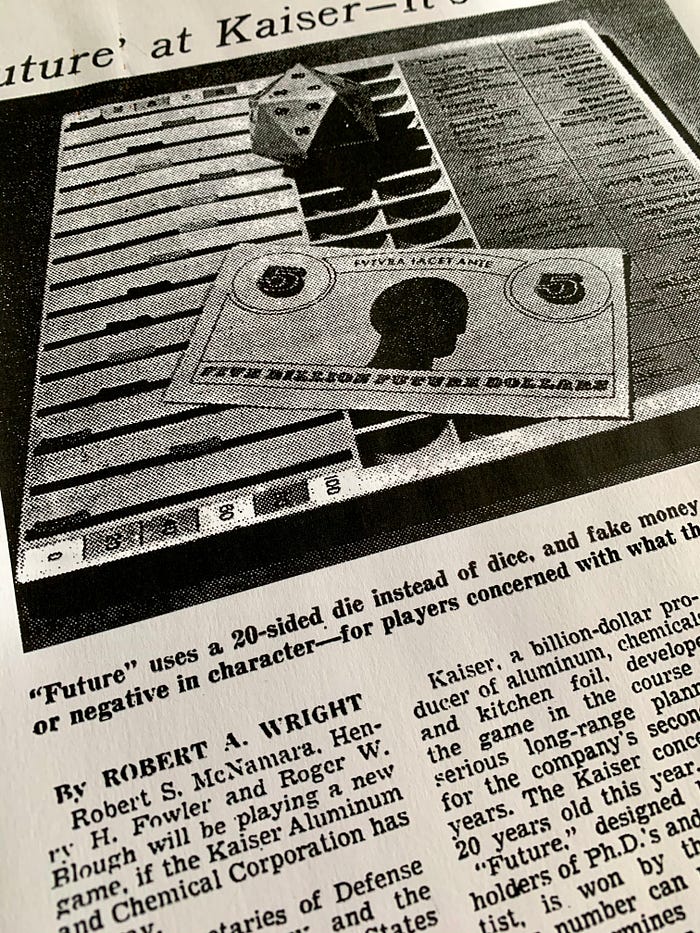 그러나 Kaiser가 사본을 배포한 후 Future 의 이야기는 대부분 조용해집니다. Gordon은 특히 도시의 미래를 보도록 수정된 한 버전을 포함하여 교실에서 게임을 사용한 소수의 교육자를 제외하고 후속 활동을 거의 기억하지 않습니다. 그는 CIA도 사본을 입수했지만 그곳에서의 사용에 대해 공개적으로 알려진 바가 거의 없다고 말했습니다. 이 게임은 일반 대중에게 제공되지 않았기 때문에 다음 10년 동안 주로 책장 장식이 되거나 중고 상점으로 표류했습니다. Gordon은 1968년에 UCLA에서 새로 사용할 수 있는 컴퓨터에서 자신과 Helmer의 계산을 다시 실행하여 보다 정교한 확률 모델을 생성하기 위해 Monte Carlo 유형 샘플링 접근 방식을 사용하여 분석을 여러 번 실행할 수 있었습니다. 이러한 교차 영향 접근 방식의 개선은 명백하게 "교차 영향 분석"으로 알려지게 된 게임의 보다 지속적인 결과를 생성했습니다. 교차 확률을 모델링하는 이 프로세스를 통해 CIA에서 연구 기관, 대학 및 싱크 탱크에 이르기까지 모든 사람이 우루과이 경제에서 원자력 기술, 글로벌 목재 산업에 이르기까지 모든 것에 대해 보다 정교하고 대규모 시뮬레이션을 실행할 수 있었습니다. 연기로 가득한 회의실. 게임은 사라졌지만 희망은 남아있다 티내가 퓨처를 언박싱하면서 가장 깊이 와 닿았던 느낌2020년 여름에 처음으로 Helmer와 Gordon이 게임 플레이를 구성하기 위해 선택한 "이벤트"가 얼마나 시의적절한지 확인했습니다. 컴퓨터 두뇌 인터페이스, 인종 장벽 제거, 주 4일 근무 외에도 가정용 로봇, 실험실에서 배양한 장기, 무료 공교육, 핵무기 등 핫 버튼 문제로 남아 있거나 다시 부상한 수많은 다른 문제가 있습니다. 감소, 합성 단백질, 3D TV, 유전자 조작, 지폐를 대체하는 신용 카드, 상업 우주 비행, 스마트 약물, 화성에 인간 착륙. 2020년 여름은 이러한 문제 중 일부를 극단적인 대조로 몰아넣었습니다. 이는 팬데믹이 전개되는 가운데 미국 전역의 행진에서 Black Lives Matter 운동의 중대한 출현을 특징으로 하며 경쟁이 치열한 선거 시즌 동안 몇 가지 획기적인 화성 임무가 시작되었습니다. 모든 미래가 한꺼번에 일어날 것 같은 이 아찔한 순간을 예고하는 이 골동품을 보는 것은 이상했습니다. 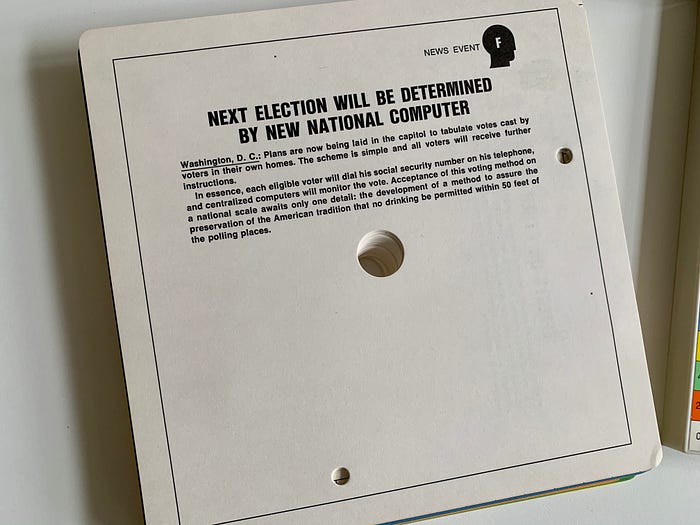 그리고 많은 해설자들이 2020년 여름에 언급했듯이 특히 미국은 1960년대 중반 이후로 이러한 난기류의 수렴을 본 적이 없습니다. 이것은 RAND가 그 시대의 정책 입안자들이 직면한 도전을 내다보고 있는 맥락이었고 Helmer와 Gordon이 지난 여름 로스앤젤레스의 Watts Riots, Timothy Leary의 LSD 실험 및 한쪽에는 스튜어트 브랜드의 "지구 전체" 폭로, 다른 한쪽에는 베트남의 확대, 충격적인 정치적 암살, 그리고 궁극적인 달 착륙이 있습니다. 내가 고든을 인터뷰했을 때, 그는 시대와 사회의 일부 근본적인 측면이 미래학자들이 생각하는 위협과 기회를 어떻게 변화시키고 있는지에 대해 반성했습니다. 앨빈 토플러는 퓨처 쇼크에서 그의 이름을 딴 시대정신 요인으로 포착했습니다 . "지금은 히피의 시대였고 사회적 규범이 바뀌고 있었습니다."라고 Gordon은 회상했습니다. “피임약은 성적 관습을 바꾸고 있었고 기관에 대한 비판이 시작되었습니다. 반란을 일으켜도 괜찮았습니다. 우리는 그 모든 결과로 대체 무슨 일이 일어날지 몰랐습니다.” 그는 미래학자와 전략가들이 다양한 출구 경로의 시나리오와 모델을 계속해서 더듬거리면서 코로나 팬데믹을 둘러싼 많은 사람들이 직면한 도전에 비유했습니다. “우리는 지금 그런 상황에 처해 있습니다. 단점은 정말 단점이고 장점이 전부는 아닙니다. 큰 격차가 있습니다. 불확실성이 높습니다. 그런 의미에서 평행선이 있습니다.” 내일과 내일 ㅏ평신도는 이 시간을 계속되는 희망과 도전의 평평한 원으로 바라보며 “왜 우리는 여전히 여기에 있는가? 미래학자들이 이것을 수정했거나 지난 50년 동안 예측을 더 잘했어야 하지 않았나요?” 간단한 대답은 미래학자는 미래를 통제하지 않고 단지 앞의 풍경을 비추며 고객, 사회 또는 둘 다의 이익을 위해 경로를 차트로 작성하려고 한다는 것입니다. 큰 그림에서 성과 또는 이정표를 향한 진행, 미래 의 대부분의 추세몇 가지 중요한 요소에 따라 달라집니다. 1986년까지 화성에 도달할 수 있는 기술을 개발하거나 20년 안에 안전한 뇌 이식을 할 수 있는 것처럼 그럴듯한 이정표였습니까? 영향을 받은 당사자 중 충분히 오랫동안 초점을 유지하여 이를 실현했습니까? 중요한 변경 사항이 발생하는 것을 가속화하거나 차단하기 위해 그동안 다른 문제가 발생했습니까? 더 복잡한 대답은 사회의 왜곡된 원거리 시야와 기술 혁신에 대한 깊은 시스템적 편견, 그리고 사회적 진보와는 거리가 먼 교차점 어딘가에 있습니다. 전자는 달러, 유로 또는 위안과 같은 가치 측면에서 이론적으로 측정할 수 있으며 후자는 우리가 변화할 만큼 충분히 가치를 부여하지 못합니다. 1964년의 관점에서 20년을 돌아본다는 것은 비범한 기술적, 정치적, 사회적 변화의 단계를 되돌아보는 것을 의미했습니다. 핵무기, 컴퓨팅의 출현, 대량 주택, 맞벌이 가구의 출현, 양극화 세계의 고착화 정치적 역학, 제약, 텔레비전, 위성 및 우주 탐사선. 이러한 발전의 퍼레이드는 예측가들이 앞으로 비슷한 변화율을 예상하도록 이끌 수 있습니다. 그러나 Facebook이 선거에 미친 영향부터 COVID-19, 러시아의 우크라이나 침공에 이르기까지 모든 것에 대한 최근 경험이 강조하듯이 기술 발전은 대략적으로 예측할 수 있지만 동반되는 사회적 변화나 경제적 또는 정치적 혁신은 쉽게 예상할 수 없습니다. 우리는 충돌의 정확한 결과를 거의 예측하지 못합니다. 통제의 메커니즘인가, 사고의 토템인가? 50대의 미래학자로서 게임에서 탐구하는 많은 문제가 오늘날 우리가 생각하는 것과 유사하게 남아 있다는 사실이 놀랍습니다. 진화했다. 그녀의 논문 " The Future Boardgame: Prediction as Power over Time "에서 Jenny Andersson은 게임이 "미래를 알고 형성하기 위한 다양한 주장을 구체화한 제어의 인공물이며, 여기에서 제안된 것처럼 미래 전문 지식의 형태.” Andersson은 계속해서 Helmer와 Gordon의 탁상용 게임을 "사회 세계를 형성하고, 사회적 갈등을 관리하고, 사회적 시간의 일반적인 혼란에 대한 질서의 형태를 만들려는 야망을 가진 강력한 소셜 기술"이라고 부릅니다. 당시 Future 는 사회적 갈등의 "어지러움", 섬세하게 균형 잡힌 군비 경쟁, 진화하는 기술. 저는 이 위치를 이전에 Institute for the Future에서 근무했으며 현재는 Stanford의 교수인 저명한 예측가 Paul Saffo에게 맡겼습니다. Saffo는 또한 수년 동안 Future 의 사본을 수집했으며 Gordon과도 연락을 유지하면서 때때로 게임에 대해 논의했습니다. " 이런 게임의 흥미로운 점은 실제로 플레이한 사람의 수가 매우 적었다는 것입니다."라고 Saffo가 말했습니다. "하지만 게임이 존재한다는 사실, 즉 사람들이 [예측에 관한] 게임을 할 가능성을 고려한다는 사실 자체가 사람들이 실제로 게임을 하는지 여부보다 훨씬 더 중요했습니다." Saffo의 관점에서 볼 때 게임의 존재 자체는 제어 메커니즘이라기보다는 열망의 중요한 표식입니다. " 게임 자체의 아이디어 : 이러한 요소를 살펴봄으로써 미래를 예측할 수 있다는 것… 그것이 큰 사건이었습니다."라고 그는 말했습니다. “수년에 걸쳐 저는 선물 분야의 나이 든 동료들을 방문했고 모두가 선반에 사본을 가지고 있었고 대부분은 개봉하지 않았습니다. 그러나 그들은 사본을 가지고 있었습니다 . 일종의 토템 아이콘이었습니다.” 미래에 대한 고려와 이해를 보다 쉽게 접근할 수 있도록 하는 이러한 열망의 한 측면은 미래 작업이 더욱 주목받게 되었습니다. Playstation, Magic: The Gathering, 다양한 롤플레잉 게임에서 성장한 젊고 다양한 전략가 및 디자이너 세대가 게임 기반 디자인을 사용하여 전문적인 예측 및 예측으로 이동함에 따라 지난 10년 동안 특히 그러했습니다. 우리가 직면할 수 있는 미래에 대한 새로운 시도를 탐색합니다. 이를 위해 탁상용 선물 게임이 널리 보급되었으며 세상을 형성하는 요인을 더 깊이 고려할 수 있는 유용하고 접근하기 쉬운 관문으로 간주됩니다. 이 게임은 옳은 것에 관한 것이 아니라 주로 문제를 인식 하고이러한 문제의 상호 연결이 촉발할 수 있는 가능성. Saffo는 그 이상을 열망한다고 생각합니다. 더 세련되고 사려 깊은 예측을 찾기 위해 더 나은 게임, 즉 더 나은 시뮬레이션을 추구하는 것은 요점을 놓치고 있습니다. “모든 도구는 같은 용도로 사용됩니다. 수정 구슬이든 주사위든 상관 없습니다. 그들은 모두 옵션과 가능성을 고려하라는 물리적 프롬프트인 [ 미래 ] 와 동일한 기능을 수행합니다 .” 이것은 아마도 50년 전에 Helmer와 Gordon이 염두에 두었던 것입니다. 이것이 바로 Herman Kahn과 같은 원시 미래학자들이 양적 확률에 대해 말하기를 중단하고 대신 이야기를 하기 시작한 이유입니다. 더 날카로운 데이터를 가지고 있거나 정확한 예측을 하거나 이론적 게임에서 승리하는 것은 중요한 것이 아닙니다. 사람들이 미래 에 대해 이야기하고 , 조사하고, 스스로 느끼고, 무엇이 미래를 주도하는지 더 잘 알게 하는 것이 중요한 요소입니다. 카드와 주사위가 있는 게임과 같은 도구는 목적을 달성하기 위한 수단이며, 우리의 다양한 기대와 이해를 수렴하는 경계 대상이며, 우리의 관점을 공유하고 지식의 격차를 메우고 가정과 미지의 것을 연결하도록 유혹합니다. 답변을 제공하는 것이 아니라 집단적 이해를 촉발하고 약간의 상상력을 발휘하는 데 가장 잘 사용됩니다. Scott Smith는 Changeist 의 미래학자, 작가 및 관리 파트너입니다 . 2020년 Kogan Page에서 출간한 " How to Future: Leading and Sensemaking in an Age of Hyperchange "의 저자이자 Susan과 함께 " Future Cultures: How to Build a Future-Ready Organization Through Leadership " 의 공동 저자입니다. Cox-Smith, 2023년 10월 출간 예정. 이 작품이 형성되는 동안 의견을 주신 Susan Cox-Smith와 Samantha Culp에게 감사드립니다. 유행병 중반 플레이 테스트와 성찰을 해준 Julian Hanna, Simone Ashby, Lily Higgins, Grace Turtle에게도 감사드립니다.
t’s just before Christmas, December 1967. Hollywood star and soft-drink mogul Joan Crawford reaches across the dining table of her Manhattan apartment, and slides a final $1 billion-dollar bill onto the game board. “Gentlemen,” she intones to her fellow PepsiCo board members arrayed around the table, “We will have commercial transportation by rocket ship by 1986.” On the other side of the continent, in Malibu, another Joan — Didion — sardonically reads a newspaper headline aloud to her assembled house guests. “Next Election Will Be Determined by New National Computer.” Across the table, future California governor Jerry Brown moves his game piece accordingly and sighs. Back east in the nation’s capital, on the patio of his DC pied-à-terre, Pentagon chief Bob McNamara sternly taps his finger on a 20-sided die, and stares down Washington Post owner Katherine Graham and fellow Potomac socialites. “80 percent probability, Katie…the numbers never lie.”  Elsewhere across America, dinner parties and game nights devolve not into rounds of Monopoly or The Game of Life, but something a bit more sophisticated — a game of prediction, testing the prognostication powers of the great and good, from garden clubs to middle American rec rooms. By the early 1970s, thanks to a brightly colored table-top game stocked with paper money, dice and a dizzying array of future possibilities, people across the country, of all walks of life, could add forecasting to their everyday skill set, alongside reading, writing and arithmetic. America had become a nation of parlor prognosticators.  Sadly, these vignettes are fictional, and this America of casual forecasters never came about. Yet, the game in question was real, though long forgotten except among a small cadre of collectors and historians of foresight. Understanding what it was, and what it meant, provides insights into why, as a culture, we may be future-curious, but remain terrible — if hopeful—forecasters. Future: A Game of Strategy, Influence and Chance was an important artifact of mid-20th century technocracy, even if it was almost entirely unknown. It was a colorful board game that attempted to teach probability, then disappeared almost as quickly as it appeared, into the closets and attics of the great and good. But its very existence as a means of bridging scientific planning and tabletop infotainment is remarkable, and its history is worth telling. I’ll claim a vested interest at this point: I’m a professional futurist, and have been working in the field for almost twenty years. The history and the artifacts of futures work hold a deep interest for me, particularly as a way of understanding how we’ve understood the future as a society, and how we build ways to imagine, probe and share ideas about it with others. My interest lies not on the accuracy of forecasts, but rather on the influence that the forecasting process holds and how it shapes society. In that light, Future was, and is, a unique boundary object — an attempt to break out of the box of scientific wonkery and cross the divide between the think tank and main street.  I had long been aware of and keen to see the game for myself, but hadn’t expected to acquire one of the surviving originals until an idle scroll of eBay one evening offered up a rare copy. A few clicks later, one of an indeterminate but small number of surviving copies in circulation was headed from a game collector in England to my front step in The Hague. In short order, a carefully taped parcel arrived. Inside, an ivory paper box featuring a modish illustration on the lid read, in cool sans serif type, simply “future.” I would later learn that the cover illustration, silhouetted head with a color-burst brain, was drawn from an ad campaign running around that time by the game’s commissioner, Kaiser Aluminium & Chemical Corporation of Oakland, California. There was a 1966 copyright hand-stamped on the side of the game box. The stark cover illustration was a repeated motif of Kaiser’s campaign which aimed to proselytize the future to its industrial customers, and the public, in the late 1960s. Stacked inside the box was a compact, almost contemporary set of molded plastic consoles with colored sliders, fitted together to make up an assembled game board, along with a plastic icosahedron, known to gamers of the past few decades as a 20-sided die. Next, four colors of racked game chips, and two shrink-wrapped packs of currency, in denominations of $1 billion and $5 billion — yes, that’s billion with a “b.” Beneath the game board, was a delicate stack of carefully hole-punched, two-sided “trend” sheets, and a set of speculative newspaper headlines, similarly hole-punched, designed to fit on pegs at the center of the game board. Both were designed to act as a paper calculator that would direct game play.  Reading down the playing board, one encounters a list of future possibilities to wager on, many of which seem stuck in time between 1966 and 2023: A guaranteed annual income. Drugs for personality control. Business by picture phone. Common use of artificial organs. Commercial space exploration. A four-day work week. Brain-computer interfaces. Free colleges and universities. Elimination of racial barriers. Clearly, Future was no Candyland or even Stratego, but something new and different: a sophisticated but attractive board game designed to teach about the future as seen from 1966. More importantly, it was designed to give leaders, industrial magnates and, possibly, average folks who came across it in schools or other contexts an appreciation of probability, and an understanding of the interconnection between the forces we think of as shaping possible futures. The game’s main ingredient is change and, most importantly, what influences it, whether through singular breakthrough innovations and achievements, new government policies, or market shifts. Within the game, mixing these ingredients alters the probabilities of change, and playing with these combinations was meant to expose players to the idea that the future is a nest of often-interconnected variables, and the likelihood of one breakthrough or shift is often bound by its linkage to another. Gaming as a way of thinking about the complexities of society and strategy wasn’t completely new in 1966. Polymath Buckminster Fuller had previously proposed and designed the World Game, an attempt at simulating the complexity of resource management. War-gaming, known for using forms and formats similar to both board and video games of today, was playing out in planning rooms around the globe during World War II. However, Future was the first notable attempt to engage civilians in the mechanics and social interaction of future forecasting. At its core, Future is what John L. Taylor, writing about the game in Architectural Digest in 1969, called a “teaching technology,” albeit one that was meant to bring some accessibility to what might otherwise be seen as an ivory tower pursuit. The catalyst for the game’s creation was the 20th anniversary of Kaiser Aluminum & Chemical Corporation, but they weren’t the principal developers of Future. In an effort to come up with a special gift to celebrate the company’s rapid post-WWII expansion — it had supplied the US government metals for aircraft and ships, and later everything from cars, to pots and pans, to TV-dinner trays — Kaiser approached the fabled RAND Corporation, which was helping it with long-range planning for the next two decades. Kaiser’s request was for RAND to create something that could teach that capability to a wider audience. Having seen success with its own ventures into what were then growth markets for cars, housing, and anything else containing products like aluminum, Kaiser wanted captains of industry to understand how making big bets on change could usefully bend the world to their interests. It wasn’t Kaiser’s first time trying to spark the public imagination about the future, however. The company had ventured into everything from geodesic domes for public architecture to space-age vehicle designs to discussing telemobility and cybernetics, investing deeply in messaging the future in the public mind over the decades. It was an early tenant of Disney’s Tomorrowland at the Disneyland park in California, selling visitors on the current and future promise of aluminum. Kaiser’s director of publications in the 1960s, Don Fabun, compiled the trippy forays into early corporate futurism found in Kaiser’s company magazine into several volumes, including “Dimensions of Change” and “Dynamics of Change,” both of which looked at coming shifts in society, technology, food, mobility and beyond.  The ideas underlying Future had an earlier inception. In 1964, Santa Monica-based RAND (an acronym standing for “research and development”) was itself already the world’s leading authority in the field of long-term strategy. Spun out of the Douglas Aircraft Company after World War II, RAND was an attempt by the US government to keep the brightest minds that had worked on the war effort together, and attract new ones. The group was primarily concerned with scientific and military questions, studying everything from the feasibility of satellites to the probabilities of nuclear conflict. But by the early 1960s, RAND had expanded to consider emerging areas of social and economic futures, reflecting broader recognition that the United States was facing just as many risks at home as overseas, or, as shown by Sputnik, in outer space. In 1964, as the Cold War was ramping up and American social conditions were heating up, RAND commissioned two of those bright minds to make the first comprehensive survey of important long-term trends for the next fifty years. For the task of experimenting with new methods of group prediction RAND tapped logician and ur-futurist Dr Olaf Helmer, a perfect pop culture embodiment of the pipe-smoking German-born professor, and a young engineer, Theodore “Ted” Gordon, then a consultant on loan from Douglas Aircraft, where he was managing development of early space vehicles. The results not only honed the development of the Delphi method, which became a bread-and-butter tool for serious futurists over the next fifty years, but they also produced a set of long-term trends which America potentially faced in its future as well as expert assessment of their probabilities over that timeframe. Their forecasts were then validated and filtered by top specialists in their fields. The paper Helmer and Gordon produced, dryly titled Report on a Long-range Forecasting Study, laid the groundwork for systematic approaches to prediction that were applied by military, commercial and academic experts for decades to come. It also further cemented the concept of relying on the collective knowledge of “expert networks” to reach a refined view of the future, a “social technology” as Helmer later called it. Aspects of these approaches show up today in everything from scenario planning to the increasingly popular forecasting tournaments described in Philip Tetlock and Dan Gardner’s bestseller, Superforecasting. Helmer and Gordon also saw the extension of these concepts in Future the game as a way to bring back the idea of long-range central planning as an acceptable and useful practice. As Helmer wrote in The Futurist magazine in early 1967, this kind of top-down planning had been tainted with a “bad odor” in the public’s view because of Cold War associations with socialism. Kitchen table gaming Kaiser reached out to RAND in the summer of 1966 through Dr. Hans Goldschmidt, a Kaiser engineer with an interest in the future. Goldschmidt was a weekend tinkerer who liked to make his own shop jigs and models, some of which he’d patented. Gordon recalled the connection to me in a 2020 conversation, particularly Kaiser’s reason for the contact: “I was working with RAND as a consultant in their math and policy department [and] Olaf and I had, time-wise, just about finished the long-range forecasting study published in 1964. We were friends, and we got this call from Kaiser, from Hans Goldschimdt saying, ‘Hey guys, we’re looking for a game since [our company is] twenty years old, and we want to commemorate that, and we want to send that out to our customers.’” Goldschmidt had called at the right moment. Gordon had been teaching across town at UCLA, and was working out some of his and Helmer’s ideas on the university’s new computer. Part of this experimentation involved building a simulation game with their forecast data and playing through variations, a practice that was increasingly common in RAND circles. The result of this was the genesis of yet another new methodology: the cross-impact matrix. By being able to calculate the impact of one trend’s probability on another, Gordon and Helmer were able to set a simulation in motion by connecting the impacts of different trends on one another — a simple version of much more complex modern game engines. For example, if trend A, with its own probability, happened around the same time as trend B, the probability of trend B occurring may change as a result — A might make it more or less likely that B occurs, and so on. According to Gordon, the seeds of this approach had come out of the work that brought him into RAND’s orbit. “At Douglas, I was doing a job I really loved,” he recalled, having recently led NASA’s nascent Saturn booster program, as well as launch of the Pioneer 1 lunar probe. “At the time, I wrote a book called ‘The Future’, and that got me to RAND, because the basic method I was using to write the book was interviewing people who were at the leading edge of their fields and asking them a simple question, ‘Where do you think it goes?’” When Goldschmidt approached RAND, Helmer and Gordon realised they had something in their pockets that might be useful: a ready-made game of predictions. Adding to that, Kaiser gave the RAND team carte blanche to turn it into something special. “It was a giveaway, and the resources of the Kaiser Company were essentially at our disposal,” Gordon remembered. “We had professional artists. If we wanted to make it out of plastic, they would make it out of plastic for us. So we had no limitations with respect to design. We could do whatever we want. So we actually sat down one day and said, this would be fun to play through. And we made the list of events or developments that constituted the cards. And then, our own judgments around that list came to life.” The process of developing the game was iterative, and followed no particular guidebook. Some mechanics and concepts were worked out at RAND’s offices on Santa Monica’s Third Street, where rooms overflowed with mathematicians and newly acquired computing tools, according to Gordon, but the core of it took quiet time on weekends, where the pair sat in Helmer’s West LA home testing different approaches. “I was at Olaf’s house, sitting at a kitchen table where we did the layout of a game,” Gordon said. “It was not the back of a napkin, but the surface of a kitchen table.”  From Helmer and Gordon’s paper version, Kaiser made some changes to put it into production. Gordon recalled to me that the process took all of three to four months in the summer of 1966, with only a rough schedule to adhere to. What they arrived at was a table-top game that had the polished look-and-feel of a mass market product of the era — a Milton Bradley-esque box of delights, with colorful labelling, matching plastic coins, currencies, and sliders, parts to assemble, and a clever system of play, heady topic notwithstanding. Players familiar with games of Monopoly and Life on a formica dinette set, or scattered across basement carpet tiles, would be at home cracking open Future on a Saturday night. Equally, the handsome box and eye-catching tones weren’t meant to be out of place on an executive’s polished office credenza, where most boxes of Future were intended to land.  Playing the future How does one make complexity playable? Fortunately, having starter forecasts at hand solved the “what” problem. The topics covered by the Report on a Long-range Forecasting Study, augmented by other issues selected by Helmer and Gordon, provided the 60 “Events” or issues that may or may not come to pass in the future. Each player is given fifteen Events, ranging in probability from 80 percent (such as “3 out of 4 people to live in cities and towns,” or “Manned military space base exists”), down to 20 percent (including “Annual wage of $6,000 is guaranteed to all breadwinners,” and “Effective physical treatment of mental illness is possible”), descending in increments of 20 percent. For each Event, a corresponding colored slider on the game board is set to the probability as determined by the experts. The next ingredient was “when.” To make forecasts a game, as with superforecasting or prediction markets, a payoff date is needed to validate a claim; one needs a date when the validity of the forecast can be concretely measured, otherwise it just remains a prediction. In the case of “Future,” Helmer and Gordon took the target date of the source study: 1986, twenty years later, setting up a symmetry with Kaiser’s 20-year commemoration. If so much had happened in politics, science and society since 1946, what might be possible another two decades hence? Future also needed a “how,” or a way to get to 1986. This is where the 20-sided die came in. With each Event set at the expert probability, something was needed to generate the aforementioned payoff, or future occurrence. A roll of the die at the reading of each Event provides a set of three numbers on the upward face which, if any match the expert-set probability, tells the player whether the forecast was “true” or not by 1986. Up to this point, Future feels like a modified game of Hi-Lo in Las Vegas. At the outset of the game, each player is asked to mark whether they agree with each forecast on a scoresheet, and the probabilities set. Events are reviewed one at a time, and a roll of the die generates a “does/does not occur” such that the player can score her “bet” against that of the expert and the simulated reality of 1986 on the die. But, this is a game about connections and contingencies, where events have impacts on the probability of other events. This is where the gameplay of Future takes on another dimension. As Event cards are played one by one, they meet or miss the rolled probability, but they also increase or decrease the probabilities of other related events. For example, if autos are barred from cities, people might work from other locations, increasing the probability of business by picture phone, as the game calls it. This exclusion might also decrease the number of cars in use. Players who have the latter two trends would adjust their respective event probabilities as the first event is played. A game of influence So the game goes, round by round, until all Events are rolled for, the future determined, the occasional surprise card or news story intervenes to spice things up, similar to Monopoly, and scores totalled. This is only for Version 1 of gameplay, though. A Version 2 is also possible, and possibly closer to reality — it’s played with money. Remember the billion-dollar bills? This is where they come in, as a means of buying probabilities upward or downward, depending on the interests of the player. With a starting pile of cash, each player can effectively bet against the other, pushing and pulling different innovations, upgrades or social breakthroughs. Of course, there is a return on these investments for winning turns, growing the cash pile of the successful future-maker, foreshadowing the cash-splashing Elon Musk, Peter Thiel and Jeff Bezos of the 2020s. As the game instructions cheekily put it, the winner is the player who “has made the most of the future.”  I asked Gordon about this aspect of the game specifically, and whether it set a less than desirable example, a question which itself shows the gap between the values of 1966 and today. “We were looking for a way to grade the accomplishments of the players,“ he told me. “Here’s your money and with it, you can change the probability of events. That’s what policy is — changing the probability of future events. We saw the money aspect as being similar to an R&D investment that has the effect of making various events more probable, in other words, like real life.” The rollout Future made the front page of the Business section of the New York Times at its launch in October 1966, touting some big names of government and industry who would be playing along including the aforementioned Secretary of Defense Robert McNamara, a known data hound whose affection for quantification some blame for the US losing Vietnam. Also included were Treasury Secretary Henry H. Fowler, Roger Blough, then chairman of US Steel Corporation, and New York City Mayor John Lindsay (also of original Batman TV series cameo fame). The game also made the cover of one of the earliest editions of The Futurist magazine in February 1967, alongside a small mention of an upcoming book by a journalist named Alvin Toffler that would deal with the future. We now know that book as Future Shock, the 1970 global bestseller that actually did put future-gazing on the pop culture map.  After Kaiser distributed its copies, the story of Future mostly goes quiet, however. Gordon remembers very little follow-on activity, aside from a handful of educators who used the game in their classrooms, including one version which was modified to look specifically at urban futures. He said the CIA also obtained a copy, but little is known publicly about its use there. Since the game wasn’t offered to the general public, it largely became bookcase ornament, or drifted into second-hand shops over the next decade. Gordon went on to re-run his and Helmer’s calculations on newly available computers at UCLA in 1968, which enabled the analyses to be run many times, using a Monte Carlo-type sampling approach to produce more refined probabilistic models. This refinement of the cross-impact approach produced the more lasting outcome of the game in what became known, plainly, as “cross-impact analysis”. This process of modeling intersecting probabilities enabled everyone from the CIA to research institutes, universities and think tanks to run more sophisticated, larger scale simulations of everything from the Uruguayan economy to nuclear technology to the global lumber industry, and many other strategic play-throughs in smoke-filled meeting rooms. The game fades away, but the hopes remain The feeling that struck me most deeply as I unboxed Future for the first time in the summer of 2020 was just how timely many of the “events” selected by Helmer and Gordon to make up the gameplay still are. In addition to computer-brain interfaces, elimination of racial barriers, four-day work weeks, there are numerous others that remain, or have resurfaced, as hot-button issues: household robots, lab-grown organs, free public education, nuclear arms reduction, synthetic proteins, 3D TV, genetic manipulation, credit cards replacing paper currency, commercial space flight, smart drugs, and landing humans on Mars. The summer of 2020 threw some of these issues into extreme contrast, featuring as it did the momentous emergence of the Black Lives Matter movement in marches across America, amid an unfolding pandemic, during what would be a contested election season, punctuated by several landmark Mars mission launches. It was strange to look at this antique that presaged this heady moment when all futures seem to be happening at once.  And, as many commentators remarked that summer of 2020, America in particular hadn’t seen such a convergence of turbulence since the mid-1960s. This was the context in which RAND was looking ahead at the challenges facing policy-makers of that era, and one in which Helmer and Gordon created the game during a summer balanced between the previous summer’s Watts Riots in Los Angeles, Timothy Leary’s LSD experiments and Stewart Brand’s “Whole Earth” revelation on one side, and escalation in Vietnam, shocking political assassinations, and eventual Moon landing to come on the other. When I interviewed Gordon, he reflected on the time and how some fundamental aspects of society were changing the threats and opportunities futurists considered, something Alvin Toffler captured as his eponymous zeitgeist factor in Future Shock. “This was the age of the hippie, and social norms were changing,” Gordon recalled. “The birth control pill was changing sexual mores, and criticism of institutions was beginning — it was alright to revolt. We didn’t know what the hell was going to happen as a result of all that.” He likened it to the challenge faced by so many around the COVID pandemic, as futurists and strategists have continued to fumble with scenarios and models of various exit pathways. “We’re in that situation now. The downside is really a downside, and the upside isn’t all that up. You’ve got a big gap — there’s high uncertainty. In that sense, there’s a parallel.” Tomorrow and tomorrow Alayperson might look at this time-as-a-flat-circle of continued hopes and challenges and ask, “Why are we still here? Shouldn’t futurists have fixed this, or gotten better at forecasting in the last fifty years?” The simple answer is, futurists don’t control the future, only illuminate the landscape ahead, and try to chart pathways through it to the benefit of their clients, society, or both. In the big picture, progress toward an achievement or milestone, which most of the trends in Future are, depends on several critical factors. Was it a plausible milestone, as in, could we even develop the technology to get to Mars by 1986 or have safe brain implants in two decades? Did enough of the impacted parties maintain their focus on it long enough to realise it? Have other issues happened in the meantime to speed up or block important change from happening? The more complex answer lies somewhere at the intersection of society’s distorted distance vision, and deep systemic bias toward technological innovation, and away from social progress. The former can be measured theoretically in terms of value — dollars, euros or yuan — and the latter we fail to value enough to change. From the perspective of 1964, looking back 20 years meant looking back at a phase of extraordinary technological, political and social change — nuclear weapons, the emergence of computing, mass housing, the emergence of dual-income households, the entrenchment of a bipolar global political dynamic, pharmaceuticals, television, satellites and space probes. This parade of advancements might lead forecasters to expect a similar rate of change ahead. But, as recent experience with everything from Facebook’s impact on elections to COVID-19 to Russia’s invasion of Ukraine highlight, while technological advancement might be roughly forecastable, accompanying social change or economic or political innovation isn’t as easily anticipated. We rarely foresee the exact outcome of their collisions. A mechanism of control, or totem for thinking? As a futurist in my 50s, it’s striking that so many of the issues explored by the game have remained similar to those we contemplate today, while methodologies for forecasting and enabling change, and attitudes about the future and who gets to speak for it, have evolved. In her paper “The Future Boardgame: Prediction as Power over Time,” Jenny Andersson writes that the game is an artifact of control that “embodied various claims to know and shape the future, and they were, or so it is proposed here, concentrates of forms of futuristic expertise.” Andersson goes on to call Helmer and Gordon’s table-top game “a powered social technology with ambitions to shape the social world, manage social conflicts, and create forms of order to the general messiness of social time.” At the time, Future, was in a way a playful version of a more serious endeavour by an elite with its hands on the levers of policy, intended to get ahead of that “messiness” of social conflict, delicately balanced arms race, and rapidly evolving technologies. I put this positioning to renowned forecaster Paul Saffo, formerly of Institute for the Future, and now a professor at Stanford. Saffo has also collected copies of Future over the years, and has stayed in touch with Gordon as well, sometimes discussing the game. “The interesting thing about games like this is the number of people who actually played it was probably very small,” Saffo told me. “But the very fact that the game existed — that people considered the possibility of playing a game [about forecasts] was in many, many ways much more important than whether people actually play the game itself.” In Saffo’s view, the game’s very existence is an important marker of aspiration, rather than a mechanism of control. “The idea of the game itself: that you could anticipate the future by looking at these factors… that was the big event,” he said. “Over the years, I would visit older colleagues in the futures field, and everybody had a copy on their shelf, most not opened. But they had a copy; it was kind of a totemic icon.” One aspect of this aspiration — to make consideration and understanding of the future more accessible — has led to futures work becoming more high profile. This has particularly been the case over the past decade, as a generation of young and diverse strategists and designers who were reared on Playstation, Magic: The Gathering, and assorted role-playing games move into professional foresight and forecasting, using game-based designs to explore new takes on the futures we may face. To that end, table-top futures games have become widespread, and are seen as a useful and approachable gateway to deeper consideration of the factors that are shaping our world. These games are not about being right, but instead, they are mainly about being aware of issues and the possibilities these issues’ interlinkages might spark. Saffo thinks to aspire to more than that, the pursuit of a better game — a better simulation — in search of more refined or thoughtful forecasting misses the point. “All tools serve the same purpose,” he told me, “I don’t care whether it’s crystal balls or dice. They all serve the same function as [Future] served, which is a physical prompt to consider options and possibilities.” This is perhaps what Helmer and Gordon had in mind fifty years ago. It’s why proto-futurists like Herman Kahn stopped speaking in quantitative proabilities and started telling stories instead. Having sharper data, making accurate predictions, or winning the theoretical game isn’t what’s important. Getting people to talk about the future, to probe it, to feel it themselves and become more aware of what drives it is the critical element is largely the objective. Tools like games with cards and dice are a means to an end, a boundary object around which to converge our diverse expectations and understandings, enticing us to share our perspectives and fill gaps in knowledge — to link assumptions and unknowns. They are best used not to deliver an answer, but to spark collective understanding, and maybe, just maybe, generate a little imagination. Scott Smith is a futurist, writer, and managing partner of Changeist. He is the author of “How to Future: Leading and Sensemaking in an Age of Hyperchange,” published by Kogan Page in 2020, and co-author of “Future Cultures: How to Build a Future-Ready Organization Through Leadership,” with Susan Cox-Smith, to be published in October 2023. Thanks to Susan Cox-Smith and Samantha Culp for comments on this piece as it was being shaped. Thanks also to Julian Hanna, Simone Ashby, Lily Higgins and Grace Turtle for mid-pandemic playtesting and reflecting. <저작권자 ⓒ ainet 무단전재 및 재배포 금지>
|
[세계미래보고서]시리즈, 판매제품
많이 본 기사
해외석학 방한인사·행사 많이 본 기사
최신기사
|




